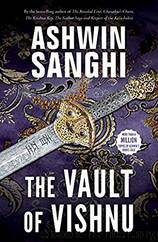The Vault of Vishnu by Ashwin Sanghi

Author:Ashwin Sanghi [Sanghi, Ashwin]
Language: eng
Format: epub
ISBN: 9789389152197
Publisher: Westland
Published: 2020-01-27T00:00:00+00:00
52
From Che-shih, I crossed the She River, 44 which was mostly still and muddy, but turbulent in places. From here, I entered the Desert of Red Sands, 45 where there was neither water nor grass. The road was lost in the barren wilderness, and I had to use the guidance of bones that lay scattered about to determine which way to go. We traversed the sands to reach Samokien, 46 the westernmost point on my journey.
Samokien had been continuously inhabited since the past 800 years and was renowned for its arts, crafts and culture. It had once been been considered one of the greatest cities of the world and still had the finest craftsmen, weavers and artisans along the Silk Route. Located in a river valley fed by melting snow, it enjoyed abundant natural resources and a temperate climate.
The rulers of Samokien had wisely invested in a complex network of irrigation canals, thus ensuring that Samokien and its surroundings were always lush green. Everywhere you looked were picturesque mountains, verdant fields, generous pasturelands, babbling brooks, gardens, reservoirs, flowers and fruit trees.
The city of Samokien was an overload for the senses in every possible way. Rich traders dressed in fine silks walked the same streets as sweaty coppersmiths, potters and paper-makers. Trotting horses, camel bells, creaking wagons, squelching mud and the cries of merchants mixed together to form a continuous daytime narrative. The smells of incense, cloves, boiling lamb, cinnamon and curry spices jostled for dominance in the bazaar.
Samokien opened its gates to all who were willing to obey the laws of trade. It was a paradise for commerce. Its market provided the widest variety of goods you could imagine. These included rare manuscripts, language and translation guides and even slaves to cater to strange human fetishes. It was often said that when the traders of Samokien gave birth to a son, they put honey on his lips and placed glue in his palms. This was to ensure that when he grew up, he would speak only sweet words while holding tight to his wealth.
The traders here were legendary for their skill in crafting profit out of thin air. Many of them had settled in other cities around the world and carried on a flourishing global trade from their new homes. You could recognise them instantly by their distinctive features—hawk nose, a bushy beard that covered most of the face and eyes that were blue, green or grey.
The commodities traded in the bazaar included cotton, spices and gems from Yindu; tea, jade work and ironware from Cina; and fur, minerals, cattle and hides from Xiyu. You may wonder why I didn’t mention silk. Silk was indeed a major commodity from Cina but it was used more as currency. People were often paid in bolts of silk, and traders found it easier to carry rolls of soft fabric than the very heavy coins that were in use. Among the most valuable items traded were living beings—horses and slaves. The Chinese were willing
Download
This site does not store any files on its server. We only index and link to content provided by other sites. Please contact the content providers to delete copyright contents if any and email us, we'll remove relevant links or contents immediately.
| Crime | Domestic |
| Financial | Historical |
| Legal | Medical |
| Military | Psychological Thrillers |
| Spies & Politics | Supernatural |
| Suspense | Technothrillers |
The Wolf Sea (The Oathsworn Series, Book 2) by Low Robert(34703)
Crowbone (The Oathsworn Series, Book 5) by Low Robert(33056)
The Daughters of Foxcote Manor by Eve Chase(23056)
The Silent Patient by Alex Michaelides(19028)
Shot Through The Heart (Supernature Book 1) by Edwin James(18432)
The Secret History by Donna Tartt(18168)
All the Missing Girls by Megan Miranda(14748)
Ready Player One by Cline Ernest(13996)
The Betrayed by Graham Heather(12306)
The Betrayed by David Hosp(12205)
Red by Erica Spindler(12026)
Bull's Eye Sniper Chronicles Collection (The Second Cycle of the Betrayed Series) by McCray Carolyn(11950)
Kathy Andrews Collection by Kathy Andrews(11328)
Warriors (9781101621189) by Young Tom(10320)
Invisible Girl by Lisa Jewell(10101)
The Last by Hanna Jameson(9804)
Year One by Nora Roberts(9304)
Mindhunter: Inside the FBI's Elite Serial Crime Unit by John E. Douglas & Mark Olshaker(8707)
Tell Tale: Stories by Jeffrey Archer(8683)
